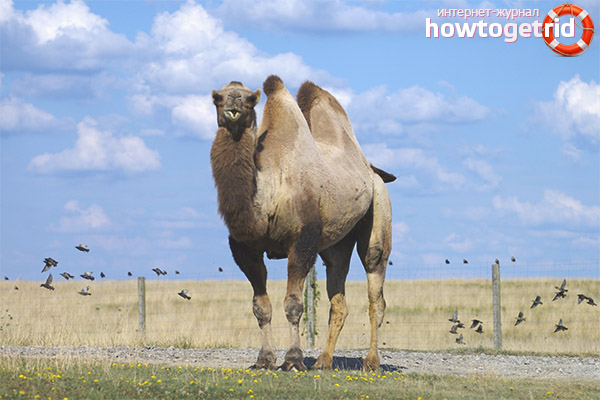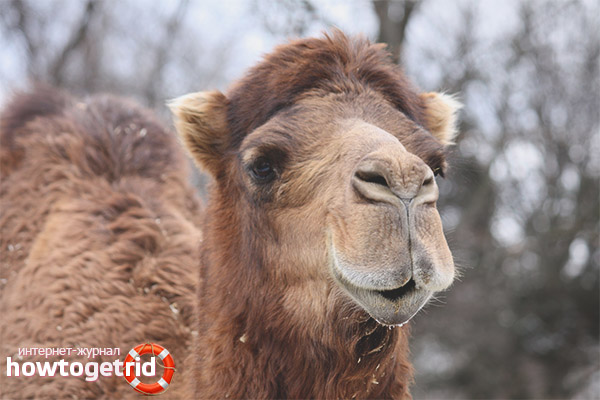The content of the article
Bactrian camel is the largest representative of its kind, living mainly in difficult-to-access landscapes. For people living in arid countries, it is very valuable, it is a vehicle widely used in movement. In addition, its meat and milk is used in food, wool also finds its application in everyday life.
Description of the species
In nature, there are two main varieties of two-humped camels, differing from each other in living conditions:
- Homemade. In Mongolia, they are called Bactrians.
- Wild. Their other name is haptagai. Small number, listed in the Red Book because of the possibility of extinction.
Both wild and domestic, they amaze with their enormous build. Males are sometimes up to 2.7 meters in height, weighs up to 1 ton. Female camels of several smaller dimensions, their weight varies from 500 to 800 kg.The tail of a camel has a tassel at the end, its length is about 0.5 meters. Two humps of camels are mobile, with the fatness of the animal, they are resilient, stand vertically, and in a state of hunger are fully or partially tilted to the sides, dangling when moving. Humps accumulate fat deposits, which are an essential nutrient reserve for the animal. The weight accumulation capacity of body fat is limited to 150 kg. In addition, the humps protect the wearer from overheating, blocking his back from the direct hit of the scorching rays of the sun. The distance between the humps is 40 cm, allowing you to equip between them a saddle for the rider.
The legs of two-humped camels are long, the legs are split into two parts, the bottom is a thick corn pillow, in front the foot is claw-shaped, resembles a hoof. Such a structure of the legs allows camels to move easily on stony or loose surfaces of the earth. Characteristically, domestic camels have corpus callosum, covering their front knees and chest area, which is not typical of their wild counterparts.
The neck of the animal is curved, very long, from the base it bends down and then rises up. The head is very large, located on the same line with the shoulders.Eyelashes are double, eyes with expressive eyes. The nostrils are in the form of slits, the ears are very small. The upper lip has a split, which facilitates the process of chewing coarse solid food.
Wool cover is painted mainly in sand color shades, sometimes reaching a dark or reddish color. The domesticated individuals are often brown, but there are also representatives of this genus of gray, white, and black. The most rare are the light camels.
The structure of camel fur is represented by hollow hairs surrounded by undercoat, which protects the camel from changes in positive and negative air temperatures. The length of the wool is from 5 to 7 cm. In the places of the peaks of the humps and in the lower part of the neck it is longer - up to 25 cm. In winter, the wool is somewhat longer and can reach up to 30 cm in length. The fur of camels falls out in scraps in the spring, during their molting. In the next three weeks before the appearance of a new coat of wool, they walk bald and unkempt.
The voice of these individuals resemble a donkey. Their hysterical cry accompanies weight lifting when it is necessary to rise from their knees or to fall on them in a loaded state.
Habitat
Bactrian camels, regardless of their belonging to wild or domestic species, are endowed with the ability to survive in sometimes harsh conditions that are unbearable for individuals of other species of the animal world. This is confirmed by their ability to live during periods of very hot dry summers or very cold winters.
In search of water sources, wild representatives of this species can travel long distances, up to 90 kilometers daily. Replenishing the body with water, they visit the rare rivers that are available, temporary spills of rain. In winter, the watering place at the rivers is replaced by obtaining the necessary water from the snow cover.
Characteristics and lifestyle

Under natural conditions, Haptagai are kept by a herd of up to 20 individuals headed by a leader, but in rare cases they can also live alone. They constantly move on stony flat areas in search of food and especially water, stopping now at one rare source, then at another. Two-humped camels lead an active lifestyle during the day, when darkness comes, apathy and lethargy manifest in their movements, more often they sleep at night. With hurricane winds, they prefer to lie down. The saving way of transferring the heat is for them to walk against the wind, thereby ensuring thermoregulation. The ravines and bushes are also used by them to search for coolness.
The temperament of haptagaev and baktrians is different. Domesticated camels are cowardly and calm in their behavior. Wild animals are fearful, but at the same time aggressively disposed. Possessing a sharp vision from nature, they see danger from afar and flee from it. Speed haptagay can reach up to 60 km. per hour, and the endurance is so great that their run can last 2-3 days, until the forces are completely exhausted and the camel will not fall in exhaustion.Haptagai are afraid of domesticated camels, considering them to be their enemies no less than tigers or wolves.
With its big head and huge body dimensions, two-humped camels are not far, when predators attack them, they are not protected, but only roar or spit. Often, even the crows are able to peck camel wounds without encountering resistance. The camel is defenseless against enemy attacks.
The saliva with which the camel spits is, in addition to it, the contents of the stomach of an irritated animal.
The winter snow period gives the camels inconvenience, they are not able to move easily through the snow, and even more so to find food under the snow. Horses come to the aid of domesticated camels, which, running through the snow, tinker it and give the camels the opportunity to pick up the food dug out from under the snow. Wild animals also have to independently search for places where ungulates have run.
Power sources
The main nutritious diet of two-humped camels is represented by coarse, low-nutrition food that is not suitable for all members of the animal world.Giants eat thorny plants, reed shoots, coarse grass. They eat not only plant food, bones and skins of representatives of the fauna are suitable for their food. They are also able to starve for a long time, the restriction of food intake does not adversely affect their health. But overeating leads to obesity of an animal, thereby disrupting the work of its internal organs. In general, camels are indiscriminate in food, eat dry grass, various cereals and dried bread.
Drinking water, including salt, representatives of this species are capable of in large quantities, up to 100 liters. at one time with prolonged absence of water. On average, being close to a river, they approach it to quench their thirst once in 3 days. Without harm to health, it is able to do without liquid lasting 2-3 weeks, replacing the lack of water with grass.
Reproduction, life expectancy
Adult camels reach the age of 3-4 years. At this age, they can multiply. The mating season for this species of animals comes in the fall. At this time period, the males are very aggressive, which is expressed by their roar, the release of foam on the lips, constant throwing and throwing at others.Males fight with rivals, bite him and kick with their feet, continuing to strike blows to the deadly end of the enemy. In the mating season, domesticated aggressive camels are tagged with rags attached to them and try to be kept separate from other individuals. Wild males become bolder and able to lead away domesticated females after themselves, and destroy males in a competitive battle.
Pregnancy lasts 13 months, the baby appears in the spring, its weight is up to 45 kg. More than one baby in a female is born very rarely, more than two never. The ability to walk baby masters already after 2 hours from the moment of birth. It feeds on mother's milk up to one and a half years. Parents care for the baby until it reaches puberty. Later it becomes independent, the newly-made male leaves the family to create herd, the female stays with her mother in herd.
There are cases of crossing single-humped and two-humped camels, as a result of which individuals appeared with one hump, extended along the entire length of the animal's back. The female received the name - May, and the male - birtugan.
Life expectancy of wild two-humped camels is about 40 years, domesticated camels, not exhausted by all the litigation that befalls wild animals, live 5-7 years longer than their tribesmen.
Video: Bactrian Camel (Camelus bactrianus)












To send